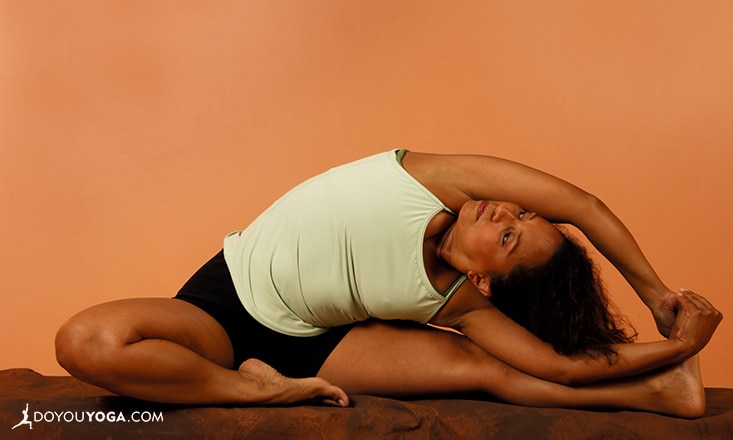"To restore," according to Merriam-Webster is defined as, "to give back (someone or something that was lost or taken), to return (someone or something), to put or bring (something) back into existence or use, and to return (something) to an earlier or original condition by repairing it, cleaning it, etc."
In essence, Restorative yoga is about giving back to our bodies something that has been lost, out of use, and no longer in its original condition. It is about taking time to repair and cleanse our bodies from the constant stress and damage applied.
Here are five benefits of Restorative yoga to give back to ourselves.
1. Smooths the Aging Process
To restore implies we all at one time we were bright, shiny, and new. Over time, we lost some of our glow. As babies, were are about 85% water and, over time, we become less fluid, loose, and elastic and are only about 70% water as adults.
Additionally, a process called contracture constantly occurs and shortens our ligaments and range of motion at any given joint. Contracture occurs organically as actin shortens the ligaments and keeps our body together like glue. It's the reason our knees start to feel tight during a long car ride and stretching feels so nice when we stand up.
Restorative yoga stretches the connective tissue (skin, bones, ligaments, tendons, and myofascial) through deep and prolonged holds of postures, which helps bring fluidity back into our lives.
2. Complements an Active Lifestyle
Restorative yoga is the perfect complement to an active lifestyle that includes muscle strengthening activities such as active asana practice, running, swimming, and weightlifting to name a few.
Contracture occurs more intensely when exercised muscles grow in girth and the fascial tissues increase at the same time and become rigid. Restorative yoga often uses bolsters, pillows, straps, blocks, blankets, and other props to allow the body’s weight and gravity to ease bone from bone, so the connective tissues that bind the body start to slowly lengthen over time.
3. Fosters the “Relaxation Response”
Yoga teacher Judith Hanson Lasater says, “collapsing is not relaxing.” Collapsing involves falling from the weight of stress and constant movement from everyday life. Relaxation involves releasing tension and returning to equilibrium.
The “relaxation response” is made up of the calming of the sympathetic nervous system, the fight or flight response, and stimulating the parasympathetic nervous system, the rest and digest response. The goal is to activate a part of the body that normally resides in the automatic nervous system, which means for the most part it runs without our conscious control, which is why we do not have to constantly focus on pumping our heart and digesting our food.
Through allowing the body to rest and focus on the breath, Restorative yoga speaks to the automatic nervous system and allow the muscles to relax, attention to move inward, and the breath to slow down.
4. Cultivates Emotional Regulation
Taking time to pause and be present in the moment are beautifully delicious concepts, yet they can at times seem very elusive and difficult to embody and employ.
Common events such as driving in traffic while running late can create road rage, anxiety, and frustration in individuals who are generally "go with the flow," present, and calm.
“We, as a society are always on the go like a car that only sees red and green lights. [!the!] fight or flight [!response!] is always running. Restorative [!yoga!] is the yellow light, it lets the body slow down to reset and build the immune system, relax the nervous system and it just feels great,” writes Vanessa Jackson, 250 hour certified Vinyasa, Yin, and Restorative teacher.
Restorative yoga offers the practitioner the chance to let go of deep-rooted emotions such as anger, anxiety, and frustration, and find flow, presence, and calmness in common events such as driving in traffic while running late.
5. Let Go of the Ego
There is no struggle to be free, the absence of struggle is in itself freedom. ~Chogyem Trungpa
This practice is about letting go of the ego and cultivating receptivity and surrender. There is nothing to give, achieve, or improve. This is the space to let go of competition, expectation, and need to change.
Instead of struggling, and in the process becoming burnt out and low on energy, Restorative yoga offers a time to pause and restore physically, psychologically, emotionally, and spiritually. Holding various postures for 5-20 minutes is hard work, thus Restorative yoga involves surrendering the struggle and letting go of the ego.
What benefits have you found from Restorative yoga? Share with us below!


